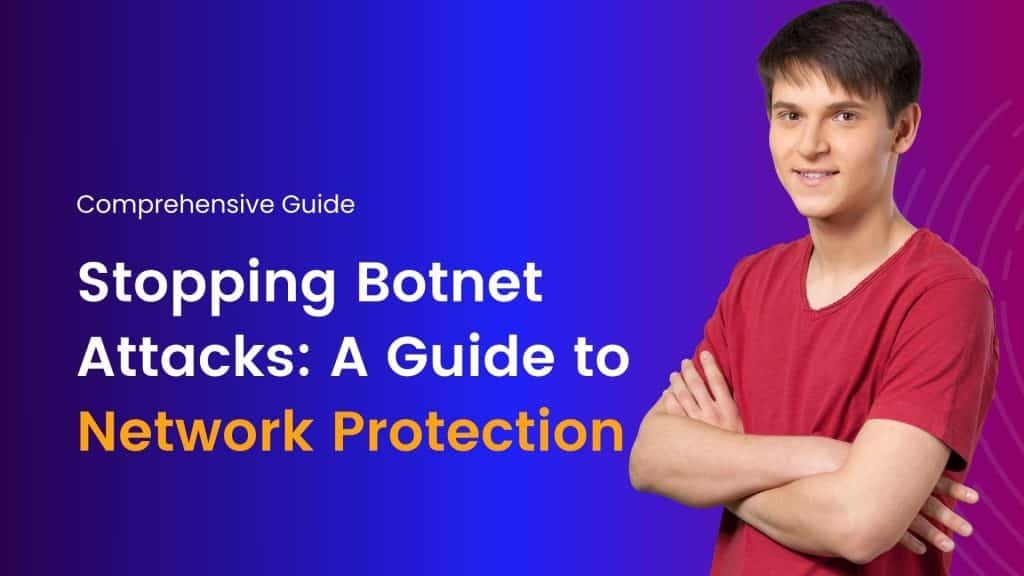In the digital age, cybersecurity threats are a growing concern for individuals and organizations alike. One particularly insidious threat is the botnet. Understanding what a botnet is and how to defend against it is crucial for maintaining the security of your network.
What is a Botnet?
A botnet, short for “robot network,” is a network of computers infected with malicious software (malware) and controlled as a group without the owners’ knowledge. These compromised computers, often referred to as “bots” or “zombies,” can be used to perform a variety of malicious activities, from sending spam emails to launching distributed denial-of-service (DDoS) attacks.
The Primary Purpose of a Botnet: Malicious Activities and Their Impacts
In the vast landscape of cybersecurity threats, botnets stand out due to their complexity and the extensive damage they can cause. A botnet, short for “robot network,” is a collection of internet-connected devices, including computers, smartphones, and IoT devices, infected and controlled by malicious software. These compromised devices, also known as “bots” or “zombies,” are remotely controlled by an attacker, often referred to as a “botmaster” or “bot herder.” The primary purpose of a botnet is to perform various malicious activities, which can have widespread and severe impacts on individuals, businesses, and even nations. This article explores the primary malicious activities conducted by botnets and their broader implications.
Distributed Denial of Service (DDoS) Attacks
One of the most common and destructive uses of a botnet is to launch Distributed Denial of Service (DDoS) attacks. In a DDoS attack, the botnet floods a targeted server, website, or network with overwhelming traffic, rendering it inaccessible to legitimate users. This type of attack can cripple online services, disrupt business operations, and cause significant financial losses. High-profile DDoS attacks have targeted major corporations, financial institutions, and even government agencies, highlighting the substantial threat posed by botnets.
Spam Distribution
Botnets are frequently used to send massive volumes of unsolicited emails, commonly known as spam. These spam emails can be used for various purposes, including phishing scams, spreading malware, and promoting counterfeit goods or services. By leveraging the sheer number of compromised devices in a botnet, cybercriminals can send millions of spam emails in a short period, effectively bypassing spam filters and reaching a wide audience.
Data Theft and Exfiltration
Another critical function of botnets is to steal sensitive information from infected devices. This can include personal data, financial information, login credentials, and intellectual property. Botmasters use keyloggers, screen scrapers, and other malicious tools to capture this data, which can then be sold on the dark web or used to facilitate further cybercrimes, such as identity theft or corporate espionage. The ability of botnets to silently infiltrate and exfiltrate data makes them particularly dangerous for both individuals and organizations.
Cryptocurrency Mining
In recent years, botnets have been increasingly employed for illegal cryptocurrency mining, a practice known as “cryptojacking.” In this scenario, the botnet hijacks the processing power of infected devices to mine cryptocurrencies, such as Bitcoin or Monero, without the device owners’ knowledge or consent. While each device contributes only a small amount of computing power, the combined effort of a large botnet can generate substantial profits for the botmaster. However, this unauthorized use of resources can significantly degrade the performance and lifespan of the affected devices.
Malware Distribution
Botnets are also instrumental in distributing other types of malware, such as ransomware, spyware, and Trojans. By using the botnet to propagate these malicious programs, cybercriminals can infect a large number of devices quickly and efficiently. Once deployed, the malware can lock users out of their systems, monitor their activities, or grant remote access to the attackers. The versatility of botnets in spreading various forms of malware makes them a potent tool in the cybercriminal arsenal.
Click Fraud
Click fraud is another nefarious activity facilitated by botnets. In click fraud schemes, the botnet is used to generate fake clicks on online advertisements, inflating the number of clicks reported to the advertiser. This fraudulent activity can cost advertisers millions of dollars in wasted marketing budgets and distort the metrics used to measure the effectiveness of online campaigns. By simulating legitimate user behavior, botnets can make click fraud difficult to detect and prevent.
Political and Ideological Attacks
Botnets can further political or ideological agendas beyond just financial gain. Cybercriminals or state-sponsored actors may deploy botnets to disrupt political campaigns, spread disinformation, or conduct cyber-espionage. These activities can undermine public trust in democratic institutions, manipulate public opinion, and destabilize societies. The use of botnets in geopolitical conflicts has become a growing concern for national security agencies worldwide.
How Botnets Work
Botnets are networks of computers infected with malicious software and controlled as a group without the owners’ knowledge. Networks can facilitate malicious activities, including spam distribution, DDoS attack launches, and data theft. Here’s a detailed overview of how botnets work:
Infection
Botnets typically begin with the infection of individual computers (bots) with malware. This can occur through:
- Phishing Emails: Emails that trick users into downloading and executing malicious attachments or clicking on harmful links.
- Malicious Websites: Websites that exploit vulnerabilities in browsers or plugins to install malware.
- Drive-by Downloads: Automatic downloads of malware when a user visits an infected website.
- Social Engineering: Tricks and manipulations that persuade users to download and install malware.
Communication
Once a computer is infected, it becomes part of the botnet and communicates with the botnet controller (botmaster). Communication methods include:
- Command and Control (C&C) Servers: Centralized servers that send commands to the bots and receive information from them.
- Peer-to-Peer (P2P) Networks: Decentralized networks where each bot communicates with other bots, reducing the risk of detection and disruption.
- Social Media and Messaging Apps: Bots can receive commands through platforms like Twitter or Telegram.
Execution of Commands
The botmaster sends instructions to the bots to perform various tasks, which can include:
- Spam and Phishing: Sending large volumes of spam emails or phishing messages to collect personal information.
- DDoS Attacks: Overloading a target website or server with traffic to make it unavailable.
- Data Theft: Stealing sensitive information such as credit card numbers, login credentials, and personal data.
- Click Fraud: Generating fake clicks on advertisements to generate revenue for the attacker.
Propagation
Botnets often have mechanisms to spread the malware to other devices, expanding the network. Methods of propagation include:
- Exploiting Software Vulnerabilities: Using known vulnerabilities in software to infect other devices.
- Brute Force Attacks: Attempting numerous username and password combinations to gain access to other systems.
- Network Scanning: Searching for other vulnerable devices on the same network to infect.
Concealment
To avoid detection and removal, botnets employ various techniques:
- Rootkits: Software that hides the presence of malware and the botnet from security software and users.
- Encryption: Encrypting communication between the bots and the C&C server to prevent interception and analysis.
- Polymorphism: Regularly changing the malware’s code to evade signature-based detection by antivirus programs.
Monetization
Attackers monetize botnets in several ways:
- Selling or Renting the Botnet: Offering the botnet as a service to other criminals.
- Extortion: Demanding ransom payments to stop DDoS attacks.
- Selling Stolen Data: Trading stolen personal information on the dark web.
Disruption and Mitigation
Efforts to combat botnets include:
- Detection and Removal: Using antivirus software and network monitoring tools to detect and remove bots.
- Shutting Down C&C Servers: Coordinating with internet service providers and law enforcement to shut down command and control servers.
- Legal Actions: Prosecuting individuals involved in creating and operating botnets.
- Public Awareness: Educating users about safe computing practices to prevent infections.
How to Stop a Botnet from Attacking Your Network
Preventing a botnet attack requires a multi-layered approach. Here are some effective strategies to protect your network:
- Update and Patch Systems Regularly: Ensure all software, including operating systems and applications, is up-to-date with the latest security patches. This helps close vulnerabilities that botnets can exploit.
- Use Strong Authentication Methods: Implement strong, unique passwords and use multi-factor authentication (MFA) to reduce the risk of unauthorized access.
- Install and Maintain Security Software: Utilize reputable antivirus and anti-malware solutions to detect and remove threats. Regularly update these tools to recognize the latest malware signatures.
- Implement Firewalls and Intrusion Detection Systems (IDS): Firewalls can block malicious traffic, while IDS can monitor network activity for suspicious behavior and alert you to potential threats.
- Network Segmentation: Divide your network into segments to limit the spread of malware. This makes it harder for a botnet to infect your entire network.
- Educate Users: Conduct regular training sessions to inform users about the dangers of phishing and how to recognize suspicious emails and websites.
- Monitor Network Traffic: Use network monitoring tools to identify unusual traffic patterns that may indicate a botnet infection.
- Employ Endpoint Detection and Response (EDR): EDR solutions provide real-time monitoring and response to threats at the endpoint level, offering greater visibility and control over potential infections.
- Backup Data Regularly: Ensure you have regular backups of important data. In the event of a botnet attack, having backups can help you recover quickly and minimize the damage.
- Engage with a Managed Security Service Provider (MSSP): For organizations lacking in-house security expertise, partnering with an MSSP can provide advanced threat detection and response capabilities.
Types of Botnets
One can categorize botnets by their structure, purpose, and control method. The following are some of the most common types:
Centralized Botnets
Centralized botnets are the traditional type, where all bots in the network communicate with a single command and control (C&C) server. This server sends commands to the bots and collects data from them. While easy to manage, centralized botnets have a significant vulnerability: if the C&C server is discovered and taken down, the entire botnet is rendered ineffective. The Zeus and SpyEye botnets primarily executed banking fraud.
Decentralized (P2P) Botnets
Decentralized or peer-to-peer (P2P) botnets operate without a central C&C server. Instead, each bot acts as both a client and a server, passing commands and data among themselves. This structure makes them more resilient to takedown efforts, as there is no single point of failure. Examples include the Storm and Waledac botnets. However, they are more complex to design and manage.
HTTP Botnets
HTTP botnets use the HTTP protocol to communicate with the C&C server, disguising their traffic as regular web traffic. This makes detection and blocking more difficult, as it blends with legitimate web traffic. These botnets often use compromised websites or cloud services to hide their C&C infrastructure. An example is the Mirai botnet, which famously took down major websites by launching massive DDoS attacks.
Social Media Botnets
Social media botnets utilize social media platforms for communication. The bots receive commands and send data through social media posts or messages, making detection challenging. This type leverages the popularity and trust of social media platforms to evade traditional security measures. The Twitter-based botnet serves as an example, where tweets conceal the commands.
IoT Botnets
IoT botnets target Internet of Things (IoT) devices, such as smart home devices, cameras, and routers, which often have weak security measures. These botnets exploit vulnerabilities in IoT devices to create a large network of bots. The Mirai botnet, mentioned earlier, is a notable example, which compromised millions of IoT devices to launch large-scale DDoS attacks.
Hybrid Botnets
Hybrid botnets combine elements of various types of botnets to enhance their functionality and resilience. For instance, a botnet might use a centralized structure for command dissemination but employ P2P communication for data collection. These hybrid models are becoming more prevalent as cybercriminals seek to create more robust and adaptable botnets.
Detecting and Responding to Botnet Infections
Despite your best efforts, there may still be instances where a botnet manages to infiltrate your network. Here’s how to detect and respond to such infections:
- Identify Infected Devices: Use security tools to scan your network for signs of infection. Look for unusual patterns such as high outbound traffic or connections to known malicious IP addresses.
- Isolate Infected Devices: Once identified, immediately isolate infected devices from the network to prevent further spread of the botnet.
- Remove Malware: Use antivirus and anti-malware software to remove the malicious code from infected devices. In severe cases, a complete system wipe and restore from backup may be necessary.
- Analyze the Attack: Investigate the attack to understand how the botnet infiltrated your network. This information can help you bolster your defenses and prevent future attacks.
- Report the Incident: Report the botnet infection to relevant authorities and organizations, such as the Cybersecurity and Infrastructure Security Agency (CISA) or a similar body in your country.
- Review and Improve Security Policies: After an incident, review your security policies and procedures. Identify any weaknesses and implement improvements to strengthen your network defenses.
Common Uses of Botnets
- Distributed Denial-of-Service (DDoS) Attacks: One of the most common uses of botnets is to launch DDoS attacks. These attacks overwhelm a target server or network with a flood of traffic, rendering it unavailable to legitimate users.
- Spam Campaigns: Botnets are often used to send large volumes of spam emails. By using a network of compromised computers, the botmaster can distribute spam more widely and evade detection.
- Data Theft: Some botnets are designed to steal sensitive information such as login credentials, financial information, and personal data from infected devices.
- Click Fraud: In click fraud, botnets are used to simulate clicks on online advertisements, generating fraudulent revenue for the botmaster at the expense of advertisers.
- Cryptocurrency Mining: Some botnets are used to mine cryptocurrencies using the processing power of the infected devices. This can lead to increased electricity consumption and reduced performance for the device owners.
“Discover how to defend your network from botnet threats with our comprehensive guide on prevention and protection strategies. Sign Up Hostao Today“
Conclusion
The primary purpose of a botnet is to perform a range of malicious activities that can have far-reaching and devastating consequences. From disrupting critical online services and stealing sensitive information to spreading malware and engaging in political sabotage, botnets represent a significant threat in the digital age. As cybercriminals continue to innovate and expand their capabilities, it is crucial for individuals, businesses, and governments to stay vigilant and adopt robust cybersecurity measures to defend against the ever-evolving menace of botnets.
Botnets are a serious threat that can compromise the security of your network and lead to significant damage. By understanding how botnets work and implementing robust security measures, you can greatly reduce the risk of a botnet attack. Regularly updating systems, using strong authentication methods, educating users, and employing advanced security tools are all essential steps in protecting your network from these malicious threats.
I'm a tech-savvy writer with a Computer Science degree and web hosting background, contributing to Hostao Blogs. I simplify complex tech topics like web development and cybersecurity. Beyond writing, I'm a tech explorer passionate about digital advancements.





















